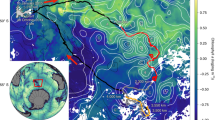Abstract
SIGNIFICANT interannual variations in global climate, such as the El Niño/Southern Oscillation phenomenon (ENSO), result from interactions between ocean and atmosphere in the tropical Pacific. These interactions are mediated to a large degree by variations in the temperature of the sea surface, particularly in the warm, western portion of the basin1–4. Changes in sea surface temperatures (SSTs) provide precursors for the prediction of climate variability on ENSO timescales. But current ocean–atmosphere models, which estimate SSTs using climatological surface heat fluxes derived from ship observations5–7, consistently overestimate SSTs in the western Pacific by as much as 3 K. Here we use recent satellite observations of ocean transparency, coupled with climatological surface heat fluxes and ocean density profiles, to show that solar radiation in visible frequencies, usually assumed to be absorbed at the sea surface, in fact penetrates to a significant degree to below the upper mixed layer of the ocean which interacts actively with the atmosphere. The net effect is a reduction of the heat input into the upper layer; for a 20-m-thick mixed layer this is equivalent to an annual reduction in temperature of about 5–10 K. Our results provide a natural explanation for the discrepancy between the SSTs predicted by models and those observed.
This is a preview of subscription content, access via your institution
Access options
Subscribe to this journal
Receive 51 print issues and online access
$199.00 per year
only $3.90 per issue
Buy this article
- Purchase on Springer Link
- Instant access to full article PDF
Prices may be subject to local taxes which are calculated during checkout
Similar content being viewed by others
References
Wyrtki, K. Science 180, 66–68 (1973).
Gill, A. E. Q. Jl R. met. Soc. 106, 447–462 (1980).
Gill, A. E. & Rasmusson, E. Nature 306, 229–234 (1983).
Cane, M. A. & Zebiak, S. E. Science 228, 1084–1087 (1985).
Seager, R., Zebiak, S. E. & Cane, M. A. J. geophys. Res. 93, 1265–1280 (1988).
Blumenthal, M. B. & Cane, M. A. J. phys. Oceanogr. 19, 815–830 (1989).
Godfrey, J. S. & Lindstrom, E. J. J. geophys. Res. 94, 8007–8017 (1989).
Lewis, M. R., Cullen, J. C. & Platt, T. J. geophys. Res. 88, 2565–2570 (1983).
Woods, J. D., Barkmann, W. & Horch, A. Q. Jl R. met. Soc. 110, 633–656 (1984).
Lewis, M. R. Oceanologica Acta Spec. Iss. 91–95 (1987).
Gordon, H. R., Clark, D. K., Mueller, J. L. & Hovis, W. A. Science 210, 63–66 (1980).
Brown, O. B. et al. Science 229, 163–167 (1985).
Feldman, G. C. et al. Eos 70, 634–641 (1989).
Austin, R. W. & Petzold, T. J. in Oceanography from Space (ed. Gower, J. F. R.) 239–256 (Plenum, New York, 1981).
Smith, R. C. & Baker, K. S. Limnol. Oceanogr. 23, 247–259 (1978).
Hsuing, J. J. geophys. Res. 91, 10585–10606 (1986).
Levitus, S. Climatological Atlas of the World Ocean. NOAA prof Pap. 13 (U.S. Government Printing Office, Washington, D.C., 1982).
Lukas, R. & Lindstrom, E. in Proc. Aha Huliko'a Hawaiian Winter Workshop on the Dynamics of the Oceanic Surface Mixed Layer (eds Muller, P. & Henderson, D.) (Hawaii Inst. Geophys., Honolulu, 1987).
Halpern, D. Deep Sea Res.A27, 931–940 (1980).
Niiler, P. & Stevenson, J. J. mar. Res. (Suppl.) 40, 465–480 (1982).
Rasmusson, E. M. & Carpenter, T. H. Mon. Wea. Rev. 110, 354–384 (1982).
Liu, W. T. J. geophys. Res. 93, 6749–6760 (1988).
Liu, W. T. & Gautier, C. J. geophys. Res. 95, 13209–13218 (1990).
EOSAT/NASA Report of the Joint EOSAT/NASA SeaWiFS Working Group (NASA, Washington, D.C., 1987).
Author information
Authors and Affiliations
Rights and permissions
About this article
Cite this article
Lewis, M., Carr, ME., Feldman, G. et al. Influence of penetrating solar radiation on the heat budget of the equatorial Pacific Ocean. Nature 347, 543–545 (1990). https://doi.org/10.1038/347543a0
Received:
Accepted:
Published:
Issue Date:
DOI: https://doi.org/10.1038/347543a0
This article is cited by
-
Observation and simulation of the diffuse attenuation coefficient of downwelling irradiance in the Polar Ocean
Science China Earth Sciences (2023)
-
Potential negative effects of ocean afforestation on offshore ecosystems
Nature Ecology & Evolution (2022)
-
Surface chlorophyll blooms in the Southern Bay of Bengal during the extreme positive Indian Ocean dipole
Climate Dynamics (2022)
-
Effects of the seasonal variation in chlorophyll concentration on sea surface temperature in the global ocean
Acta Oceanologica Sinica (2021)
-
Influence of ocean salinity stratification on the tropical Atlantic Ocean surface
Climate Dynamics (2021)
Comments
By submitting a comment you agree to abide by our Terms and Community Guidelines. If you find something abusive or that does not comply with our terms or guidelines please flag it as inappropriate.



